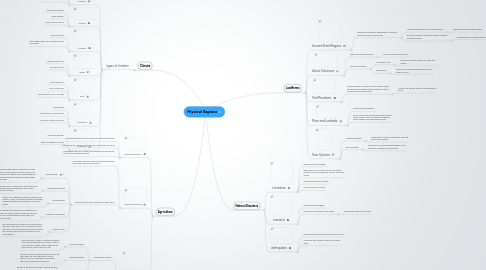
1. Agriculture
1.1. specialized farming
1.1.1. Specialized agriculture is farming for a specific product
1.1.2. Raising organic foods is another type of specialized farming
1.1.3. Specialized farming is pretty much commercial agriculture, just with a specialized market.
1.2. commercial farming
1.2.1. commercial farming is just to raise products and sell it with commercials later on
1.2.2. factors that can affect this kind of agriculture
1.2.2.1. raw materials
1.2.2.1.1. commercial agriculture usually rely on a big supply of raw materials. poultry farms don't raise chicks on they're own instead they just buy big patches of chicken and keep under warm light.
1.2.2.2. location and climate
1.2.2.2.1. influences most to the farming. the climate, the soil and the natural vegetation varies wildly from place to place.
1.2.2.3. transportation
1.2.2.3.1. grains, corn, wheat and such are harvested by tractors, plows, combine-harvesters and other machines. wheats are trucked off to railroad points
1.2.2.4. machinery and labour
1.2.2.4.1. the balance of the labour and machinery can differ from one to another. intensive farming takes up ain the growing season they use small machines
1.2.2.5. market forces
1.2.2.5.1. the costumers play a big role on deciding the success or the failure of a commercial farmer. we taste it and see which one would be better. we compare the prices to see which one is more worth it.
1.3. subsistence agriculture
1.3.1. subsistence farmers
1.3.1.1. nomadic herders
1.3.1.1.1. herds of goats, camels or cattle are used by nomadic herders.they are in Africa, central Asia, and semi-desert regions. they would farm for milk, meat, hair and such.
1.3.1.2. small landholders
1.3.1.2.1. found in mexico, south america, africa, south asia. they own small permanent farms. raises corn, rice, vegetables. everyone in the family helps with the farming.
1.3.1.3. shifting cultivators
1.3.1.3.1. groups in the tropical forests of south america, africa and south asia are shift cultivators. they cut off small areas of jungles and then root crops like yams or cassavas.
1.3.2. subsistence agriculture when the land isn't fit for commercial farming or living to survive and feeding your family.
2. Climate
2.1. types of climates
2.1.1. maritime
2.1.1.1. near large water bodies
2.1.1.2. located around coastlines
2.1.1.3. warm summer , cold winter
2.1.2. tropical
2.1.2.1. around the equator
2.1.2.2. warm weather
2.1.2.3. warm all year around
2.1.3. mountain
2.1.3.1. near mountains
2.1.3.2. less oxygen when you go higher up the mountains
2.1.4. desert
2.1.4.1. South america/Asia
2.1.4.2. very dry/no rain
2.1.5. polar
2.1.5.1. Arctic/Antarctic
2.1.5.2. very cold all year
2.1.5.3. does not get a lot of sun light
2.1.6. continental
2.1.6.1. everywhere
2.1.6.2. hot summers, cold winters
2.1.6.3. drier than maritime climate
2.1.7. temperate
2.1.7.1. below the equator
2.1.7.2. gets it sunlight at an angle
3. Landforms
3.1. Ancient Shield Regions
3.1.1. these were created by widespread of volcanic activities billions of years ago.
3.1.1.1. composed large amount of igneous rocks
3.1.1.1.1. made fully from solidified magma
3.1.1.2. heat and pressure altered some parts of these old shield regions
3.1.1.2.1. metamorphic rocks were formed then
3.2. Active Volcanoes
3.2.1. where volcanoes are found
3.2.1.1. Found around the ring of fire
3.2.2. types of volcanoes
3.2.2.1. composite cone
3.2.2.1.1. formed by different layers of cinder and magma
3.2.2.2. shield cone
3.2.2.2.1. formed fully with magma throughout the whole volcano
3.3. Fold Mountains
3.3.1. fold mountains are made from two plates under ground collide together bending layers of rocks to look like a wrinkled carpet.
3.3.1.1. can only be formed slowly over hundreds of years
3.4. Plains and Lowlands
3.4.1. located along coastlines
3.4.2. rivers and glaciers carries sediments into the ancient seas turns in to thick beds that will slowly solidify into sedimentary rocks
3.5. River Systems
3.5.1. dendritic drainage
3.5.1.1. eroded from 1 lake to many other ones like how a tree is grown
3.5.2. trellis drainage
3.5.2.1. geometry of a trellis drainage system is like the trellis in gardens to grow vines
4. Natural Disasters
4.1. tornadoes
4.1.1. happens in warm weather
4.1.2. when warm air rises and cold air come down the warm air runs around the cold air forming a vortex
4.1.3. will tear everything in its way
4.1.4. forms usually on flat land
4.2. tsunamis
4.2.1. flushes everything away
4.2.2. caused by earthquakes under water
4.2.2.1. shaking the water to the coast
4.3. earthquakes
4.3.1. people will fall in to the cracks and will be hurt
4.3.2. caused by two plates rips apart from each other
